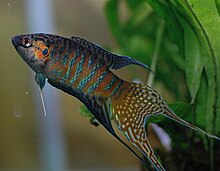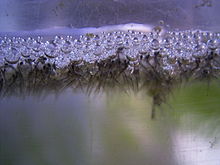Macropod
| Macropod | ||||||||||||
|---|---|---|---|---|---|---|---|---|---|---|---|---|

Male macropod ( Macropodus opercularis ) with wild coloring |
||||||||||||
| Systematics | ||||||||||||
|
||||||||||||
| Scientific name | ||||||||||||
| Macropodus opercularis | ||||||||||||
| ( Linnaeus , 1758) |
The macropod ( Macropodus opercularis ), also called paradise fish , fork-tailed macropod , large fins or gill patch , belongs to the genus of paradise fish from the subordination of labyrinth fish . The males are about 8 cm tall and are beautifully colored, especially in the mating season, the females stay a little smaller and have a rather plain brown color. In addition, the males have long fin tips ("filaments") in the caudal, anal and dorsal fin.
Origin of name
Macropodus : from the Greek μακρός (makrós) for "long, large" and ποδός (podós) for "foot, leg", because of the sometimes elongated fins of the genus, especially the sexually mature males.
opercularis : probably a reference to the significant stain on the gill cover , the so-called opercular spot , from Latin operculum (gill cover).
Synonyms
Labrus opercularis Linnaeus , 1758; Labrus operculatus Gmelin , 1789; Chaetodon chinensis (Bloch, 1790); Macropodus chinensis (Bloch, 1790); Macropodus viridi-auratus La Cepède , 1801; Macropodus venustus (Cuvier)
Appearance
The paradise fish reaches a length of up to 10.4 cm from the tip of its mouth to the filaments of the caudal fin, the standard maximum length is 70 to 80 mm. Another source gives a maximum length of 6.7 cm and an average length of 5.5 cm. Within the labyrinth fish he is one of the medium-sized representatives. The caudal fin is deeply forked and drawn out long. The basic color of the body is gray-yellow to green-yellow; in general the body color changes within the reproductive period. Females are generally more inconspicuous in color than males.
There are blackish spots on the forehead and front back, which can vary greatly from individual to individual. Typical for this species are six to eleven horizontal stripes across the body, the color of which can vary between brick-red and red-brown.
The opercular spot, which is the evolutionary feature of this genus, is light green to dark blue. At the rear edge it has a brick-red edge. Also noticeable is the dark reins that lead from the eye towards the opercular spot.
During courtship , the coloring of the male is more intense and bright. The fins and the upper half of the body then often have a blue tinge. The color contrast of the ultramarine blue colored anal fin and its white border is then clearly noticeable. The pelvic fins are light blue. The first soft ray, which is greatly elongated, has a red color at the end.
Distribution area
Autochthonous occurrence

Their distribution area is in low-oxygen ponds and ponds from China to Southeast Asia. However, the exact limits of the natural range are not easy to determine. In many places the macropod was abandoned as well as other species of this genus, so that there are a number of allochthonous occurrences. However, the main distribution area is in any case central and southern China . It also occurs on the two islands of Hainan and Taiwan off the Chinese mainland . He can also be found in North Vietnam . In Hanoi it can be found in almost all urban waters. In Ho Chi Minh City, however, he is missing.
The type locality is believed to be near Guangdong in southern China.
Allochthonous occurrences
Its distribution in South Korea , Japan , Malaysia , Singapore , India, and the United States is human.
habitat
The macropod prefers bodies of water that are densely populated with aquatic plants . In the vicinity of Hanoi, the waters it populates often have mussel flowers ( Pistia stratiotes ) or water hyacinths ( Eichhornia crassipes ). They offer the fish the opportunity to create their foam nests .
Paradise fish can also be found in rice fields when they are about 15 centimeters high, but mostly in their tributaries. They are often associated with East Asian mud lobsters ( Misgurnus anguillicaudatus ), gill-slit eels ( Monopterus javaensis ), rice parsons ( Oryzias latipes ) as well as carp , crucian carp and goldfish .
Way of life
General behavior
Macropods are very calm fish that also take longer periods of rest during the day and occasionally rest on the leaves of aquatic plants. During this time their breathing is also reduced. During the night, the fish either stay briefly below the surface of the water or rest on plants in deeper water layers.
The caudal fin is the main driving and controlling organ in swimming. However, they are not particularly fast, persistent or agile swimmers. The pectoral fin serves to balance the body. She is almost constantly in a fanning movement.
Behavioral repertoire
Observations in the aquarium have shown that Macropodus opercularis mutually transport eggs or young fish from other foam nests into their own.
With the help of specifically spat out water, they can make food that is above the water line accessible.
In addition, noises can be heard that originate from the animals.
Aquaristics
First import
A French soldier with the surname Gerault introduced Macropodus opercularis from Ningbo to European aquaristics in 1869, initially in France. Of the hundred introduced, 22 survived. In the same year they were bred by Pierre Carbonnier. Macropodus opercularis is therefore one of the first introduced aquarium fish, i.e. ornamental fish. In 1876 the species was introduced in Germany.
attitude
The fish are easy to keep in the aquarium because the animals are relatively undemanding. Keeping them without heating and filter systems is possible, the fish even like slight algae. An abundantly planted basin comes close to the natural habitat of animals in Asia. Some hiding places or caves are also appropriate, this reduces aggressive behavior, which is sometimes noticeable due to the territorial demands in the narrow aquarium, especially if the fish are exposed to high temperatures in a warm water aquarium outside the mating season. It is often not advisable to keep multiple males together. There is then a high probability of very aggressive behavior and fights, which can even end with death. This is especially true for small aquariums with few places to hide. It is also not recommended to keep fish with very colorful and large tail fins such as certain guppy species or the Siamese fighting fish .
However, they can easily be socialized with bass bass and fish of similar size and behavior.
Because of their origin, the animals are very temperature-tolerant. Down to 10 ° C - provided that the cooling is not too abrupt - do not pose a problem for well-being, which can be proven in terms of behavior, eating behavior, coloration and susceptibility to disease.
A cool overwintering in the winter months is beneficial.
breed
Breeding in the aquarium is also quite often successful . The brood care behavior is interesting : the males - like all labyrinth fish - build a foam nest in which the eggs are laid. The clutch itself is then guarded by the male until the young hatch and defended against intruders. This brood care behavior is called the " father family ". The female secures the outer borders of the area. Held in the garden pond from May or June to September, a large number of offspring can often be fished in autumn.
At lower temperatures, the fry grow more slowly. This leads to a strong body and the formation of larger fins than if the young fish were reared too quickly in so-called “steam breeding” at too high temperatures, which can also lead to dwarfism.
Cultivated forms and wild forms in the aquarium hobby
So far, there are essentially four color varieties through breeding selection:
On the one hand, this is the “ albino ” macropod and / or a xanthorous form. The albino macropod is pink with a reddish band pattern and often has impaired eye performance.
The best known and most widespread is the blue form ("Blue"). It was created in the 1950s. In the 1990s, a streak-free, red shape was created. Around 2011 a blue stripe-free shape was added, which has a wide reddish to orange-brown band on the flanks.
In addition, specialists also keep wild forms and reproduce them as pure as possible, such as forms from localities such as Nanking , Dong Hoi or Taiwan.
Due to so-called "steam breeding", there are mostly pale fish on the market in Germany, which do not achieve the splendor of the wild forms or skillful breeding of the color varieties.
Trivia
The membership magazine of the International Labyrinth Fish Association (IGL), which appears four times a year, has been called "Der Makropod" since it was founded in 1979. It is a trade journal ( ISSN 0937-177X ). The logo of the International Labyrinth Fish Association (IGL) also shows a - stylized - macropod. In addition, the macro pod was depicted several times on postage stamps.
literature
- Hans-Joachim Paepke: The paradise fish: genus Macropodus. In: The New Brehm Library. Volume 616. Westarp Sciences, Magdeburg 1994, ISBN 3-89432-406-6 .
- Thomas Seehaus, Jürgen Schmidt: Macropods - paradise fish . Ruhmannsfelden, Bede-Verlag 2002, ISBN 978-3-89860-005-7
- Horst Linke: Labyrinth fish . Berlin-Velten, Tetra Verlag 2017, ISBN 978-3-89745-260-2
Web links
- Homepage of the International Labyrinth Fish Community with a forum on macropods
- www.casa-di-lago.de: Aquarium keeping and breeding of macropods
- Macropodus opercularis inthe IUCN 2013 Red List of Threatened Species . Posted by: Huckstorf, V., 2010. Retrieved December 10, 2013.
Individual evidence
- ↑ a b c d e f g SPECIESPROFILE Macropodus opercularis (LINNAEUS, 1758) Paradise Fish. In: Seriously fish. Retrieved May 24, 2019 .
- ↑ a b Fork-tailed macropod, Macropodus opercularis. Panta Rei, accessed May 22, 2019 .
- ↑ Cuvier & Valenciennes 1831; Macropodus filamentosus. Oshima, 1919; (?) Macropodus baviensis Nguyen [HD] & Nguyen [VH], in Nguyen [VH], 2005.
- ↑ a b Macropodus opercularis (Linnaeus, 1758) Paradisefish in fishbase. Retrieved May 24, 2019 .
- ↑ The paradise fish - Macropodus opercularis in: The great aquarium advice. Retrieved May 28, 2019 .
- ↑ a b c d A new cultivated form of paradise fish in: Aquarium Glaser. Retrieved May 24, 2019 .
- ↑ https://www.aqualog.de/lexikon/macropodus-opercularis-albino/
- ↑ http://igl-home.de/der-makropode.html Magazine page of the homepage of the International Association for Labyrinth Fish
- ↑ http://igl-home.de/ Homepage of the international community for labyrinth fish





